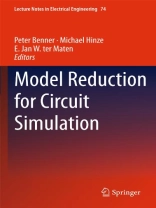Simulation based on mathematical models plays a major role in computer aided design of integrated circuits (ICs). Decreasing structure sizes, increasing packing densities and driving frequencies require the use of refined mathematical models, and to take into account secondary, parasitic effects. This leads to very high dimensional problems which nowadays require simulation times too large for the short time-to-market demands in industry. Modern Model Order Reduction (MOR) techniques present a way out of this dilemma in providing surrogate models which keep the main characteristics of the device while requiring a significantly lower simulation time than the full model.
With Model Reduction for Circuit Simulation we survey the state of the art in the challenging research field of MOR for ICs, and also address its future research directions. Special emphasis is taken on aspects stemming from miniturisations to the nano scale. Contributions cover complexity reduction using e.g., balanced truncation, Krylov-techniques or POD approaches. For semiconductor applications a focus is on generalising current techniques to differential-algebraic equations, on including design parameters, on preserving stability, and on including nonlinearity by means of piecewise linearisations along solution trajectories (TPWL) and interpolation techniques for nonlinear parts. Furthermore the influence of interconnects and power grids on the physical properties of the device is considered, and also top-down system design approaches in which detailed block descriptions are combined with behavioral models. Further topics consider MOR and the combination of approaches from optimisation and statistics, and the inclusion of PDE models with emphasis on MOR for the resulting partial differential algebraic systems. The methods which currently are being developed have also relevance in other application areas such as mechanical multibody systems, and systems arising in chemistry and to biology.
The current number of books in the area of MOR for ICs is very limited, so that this volume helps to fill a gap in providing the state of the art material, and to stimulate further research in this area of MOR. Model Reduction for Circuit Simulation also reflects and documents the vivid interaction between three active research projects in this area, namely the EU-Marie Curie Action To K project O-MOORE-NICE (members in Belgium, The Netherlands and Germany), the EU-Marie Curie Action RTN-project COMSON (members in The Netherlands, Italy, Germany, and Romania), and the German federal project System reduction in nano-electronics (Syre Ne).
Spis treści
Part I Invited Papers.
1 The need for novel model order reduction techniques in the electronics industry;.W.H.A.Schilders. 2 The SPRIM Algorithm for Structure-Preserving Order Reduction of General RCL Circuits; R. W. Freund. 3 Balancing-Related Model Reduction of Circuit Equations Using Topological Structure; T. Stykel. 4 Topics in Model Order Reduction with Applications to Circuit Simulation; S. Lefteriu and A.C. Antoulas.
Part II Contributed Papers.
5 Forward and Reverse Modeling of Low Noise Amplifiers based on Circuit Simulations; L. De Tommasi, et al. 6 Recycling Krylov Subspaces for Solving Linear Systems with Successively Changing Right-Hand Sides Arising in Model Reduction; P. Benner and L. Feng. 7 Data-driven Parameterized Model Order Reduction Using z-domain Multivariate Orthonormal Vector Fitting Technique; F. Ferranti, et al. 8 Network Reduction by Inductance Elimination; M.M. Gourary, et al. 9 Simulation of coupled oscillators using nonlinear phase macromodels and model order reduction; D.Harutyunyan and J. Rommes. 10 POD Model Order Reduction of Drift-Diffusion Equations in Electrical Networks; M. Hinze, et al. 11 Model Reduction of Periodic Descriptor Systems Using Balanced Truncation; P. Benner, et al. 12 On synthesis of reduced order models; R. Ionutiu and J.Rommes. 13 Model Reduction Methods for Linear Network Models of Distributed Systems with Sources; S. Ludwig and W. Mathis. 14 Structure preserving port-Hamiltonian model reduction of electrical circuits; R.V. Polyuga and A.J. van der Schaft. 15 Coupling of numerical and symbolic techniques for model order reduction in circuit design; O. Schmidt et al. 16 On Stability, Passivity and Reciprocity Preservation of ESVDMOR; P. Benner and A. Schneider. 17 Model order reduction of nonlinear systems in circuit simulation: status and applications; M. Striebel and J.Rommes. 18 An Approach to Nonlinear Balancing and MOR; E. I. Verriest.












